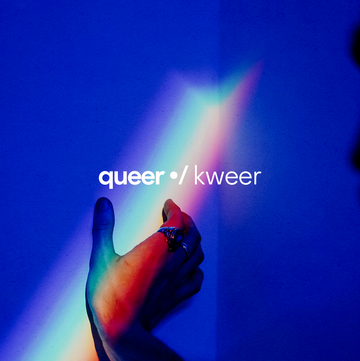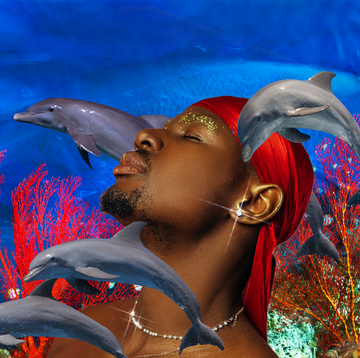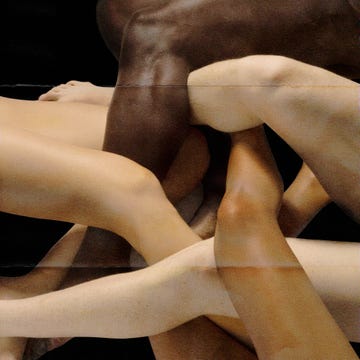While the terms gender, sex, and sexual orientation may oftentimes be thrown around in the same sentence, they actually all encompass very different meanings. And because of the many ways people can look and express themselves, it's important—maybe now more than ever—to be respectful and aware of the right language to use.
This starts by understanding the difference between gender, gender expression, sex, and sexual orientation.
As a general overview: "Sex is biological, gender is social, " says Deborah J. Cohan, PhD, associate professor of sociology at the University of South Carolina Beaufort and the author of Welcome to Wherever We Are: A Memoir of Family, Caregiving and Redemption. "Gender is the social significance given to biological sex differences. It becomes the overlay of expectations and values."
(And if you need an easier way to remember the difference, Dr. Cohan says a transman once told her "sex is what's between your legs, and gender is what's between your ears.")
But that's just the basic definition and barely scratches the surface. So allow us to dive deeper into the differences between gender, gender expression, sex, and sexual orientation. With the help of these three gender experts, you can have a better grasp on these concepts and learn how to be an ally no matter how you identify.
How Sex is Defined
When it comes to the idea of sex, it is not just about the physical act of having it. Sex also has a biological component that directly correlates with the genitalia you're born with. For example, if you are born with a penis and have XX chromosomes, you are identified as a male on your birth certificate. If you are born with a vagina and have XY chromosomes your birth certificate will be labeled as female.
This is why you may hear people use the phrase "assigned at birth" when speaking about their sex.
Sex therapist Kelly Wise, PhD, points out, though, that there are also intersex folks. Those who are intersex may have reproductive anatomy and/or chromosomes that don’t match the traditional definitions of female or male. As a result, they will be labeled as “intersex.”
For example, a child could be born genetically male with one X and one Y chromosome, but because their body is unable to respond to certain male sex hormones (called androgens), they may have mostly female sex characteristics or signs of both male and female sexual development.
The Difference Between Sex and Gender
Just because you are labeled one way on your birth certificate doesn't mean your gender identity or gender expression will match. Remember, gender is a social construct that is incredibly performative. It is tied directly to the ways in which people express themselves and one's innermost concept of self.
So the biggest different is this: Sex is biological and something that you're assigned at birth. Gender is a social construct that each of us gets to decide based on what we know to be true for ourselves.
Now for people who do identify with the gender they were assigned at birth, this is called cisgender. "If you were born with a vagina and identify as a girl/woman or were born with a penis and identify as a boy/man, this means that you are cisgender,” Dr. Cohan said.
But for people who are transgender, this means their sex assigned at birth does not match their gender identity. There are other categories of identity as well, such as non-binary, which generally means a person doesn’t identity with being defined as male or female. Folks sometimes also use the term gender fluid, which means that someone’s gender can morph and may be different at various points.
Keep in mind there are countless ways to express gender, and there is no right or wrong way to do this. There is no roadmap about how to experience this and each person’s journey is different.
If you’re wondering about your own gender identity, Dr. Wise, who is transgender, notes that there is no need to rush to put a label on yourself. It’s okay to take your time or change the way you describe your gender over time. “There is so much space to be an individual,” he says. “[Gender] ends up being one factor about you and not your whole defining exhibit. There is no rush to figure it out and you don’t have to limit yourself.”
What Sexual Orientation Means
When it comes to understanding these larger concepts, it is important to remember that someone's gender and sexual orientation are not the same thing. Gender is, again, a social construct tied to personal expression, while sexual orientation is defined as who you are attracted to. One is not contingent upon the other.
Some examples of someone's sexual orientation might be gay, lesbian, bisexual, queer, etc. and this has nothing to do with their gender identity, which may be cisgender, transgender, non-binary, gender fluid, etc. Sexual orientation is solely based on who you are attracted to.
Gender Expression
You know the phrase “appearances can be deceiving”? Yeah, well, this is one thing that rings true when it comes to gender expression. Part of the reason people sometimes struggle with this idea has to do with the larger concepts of gender norms and what is deemed as “masculine” and “feminine." Especially because of the stereotypes that surround this concept—like that only women only wear dresses and only men wear suits.
So while someone’s gender expression or presentation—which includes everything from their style of dress, mannerism, interests and other elements—may suggest to you that they look a certain way, they in fact may identify in another way.
The best thing you can do is not assume people’s gender expression or identity based on how they may appear to you. Even if someone has a more masculine, feminine, androgynous look, or a combination of these, their gender expression isn’t tied to their sexuality.
That is why it is important to meet people where they are at and ask questions such as “Hey, what are your gender pronouns?” This can help you better understand them and also respect the person you are with.
Tips on How to Become a Better Ally
While you may not identity as transgender, queer, gender fluid, or whatever else, you can still bring attention to issues surrounding these groups by helping to amplify their voices and existence as human beings.
Educating yourself is one way to become a better ally. Learning about these larger gender concepts and being aware of how you view these things in relation to one another and the world is important. There are lots of resources online and through social media that can help you learn to be more inclusive. Check out a website like GLAAD.
Another thing: It's important to avoid using gendered phrases such as “guys, girls, etc” and saying things such as “everyone, everybody, or folks” instead. Especially in the work setting, but really, anywhere.
You can also ask questions such as “How do you identify?” and “What are your preferred pronouns?” when meeting people for the first time. This can allow you to learn more about that person’s lived experience and also about them as a person.
Financially contributing to specific causes is also another great way to help out. There are lots of organizations and causes that take donations such as The Trevor Project, The Human Rights Campaign, and others. Doing a search for gender-based groups in your area and seeing which ones you want to contribute to or even volunteer at can also help you make a bigger impact in your own community.
Lastly, one of the biggest ways you can be an ally is to not make assumptions about people in general. Be mindful, educate yourself, ask questions, and support people in the ways they need.














